Balloon molly fish is a freshwater species that can be found in many tropical aquariums. What makes this little fish popular is that it is cute, peaceful, as well as easy to breed and care for.
With charming behaviors and nice colors, a couple of balloon mollies can keep watchers engrossed for hours. Mollies are generally suitable for new aquarists and hobbyists.
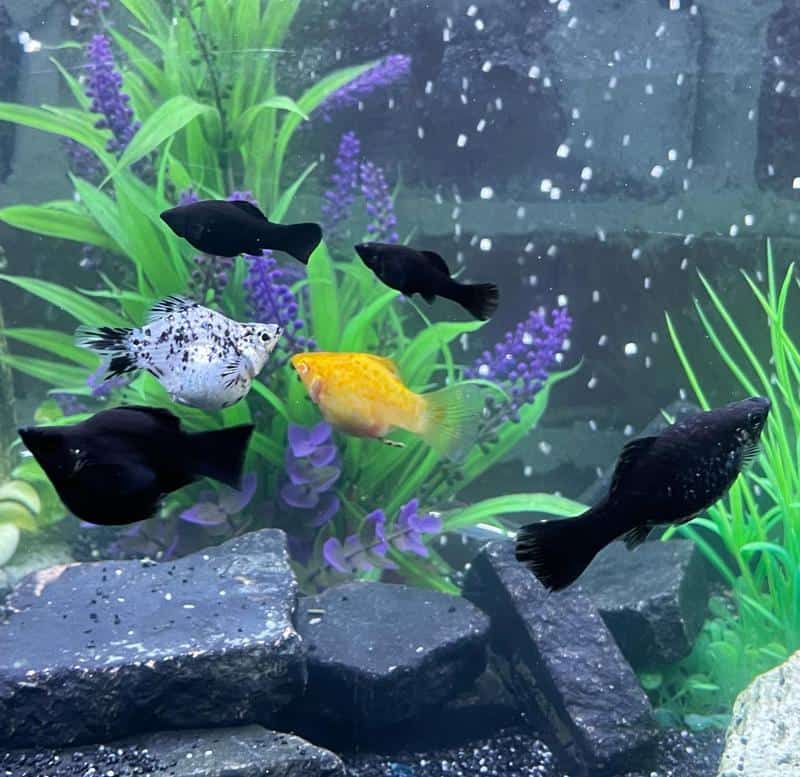
Despite the fact that they are easy to care for, it’s important to find out more about their needs and features beforehand. This can make sure mollies thrive after purchase.
In this guide, you will familiarize yourself with gregarious and gorgeous balloon molly fish. We will talk about balloon molly care, size, temperature, tank size, pregnancy, lifespan, colors, and so on. Let’s take the plunge!
What’s Balloon Belly Molly?
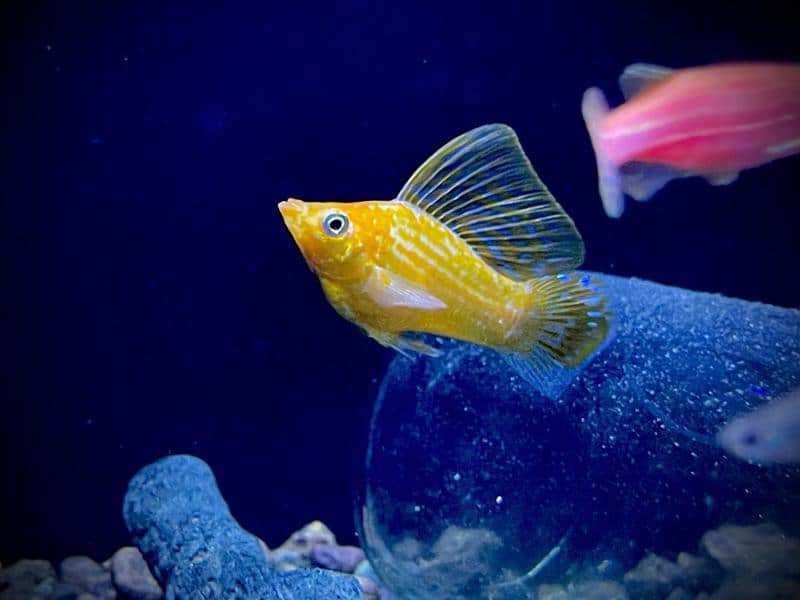
Basic Facts
Balloon molly fish (also called balloon belly molly or balloon molly) is a live-bearing species of fish that’s native to Central America and Mexico. As a new freshwater type of fish, it was documented in 1940.
Since then, balloon molly (Poecilia sphenops) has inhabited areas around the world. They are invasive in many natural habitats today.
These omnivores belong to the large Poeciliidae family. Although there are more than 70 Poecilia species available, only 3 are popular among fishkeepers: guppies, swordtails, and mollies.
Here, we will focus on balloon belly molly fish. They come in different colors and sizes. Keep reading to discover more facts about these brightly colored critters.
Appearance
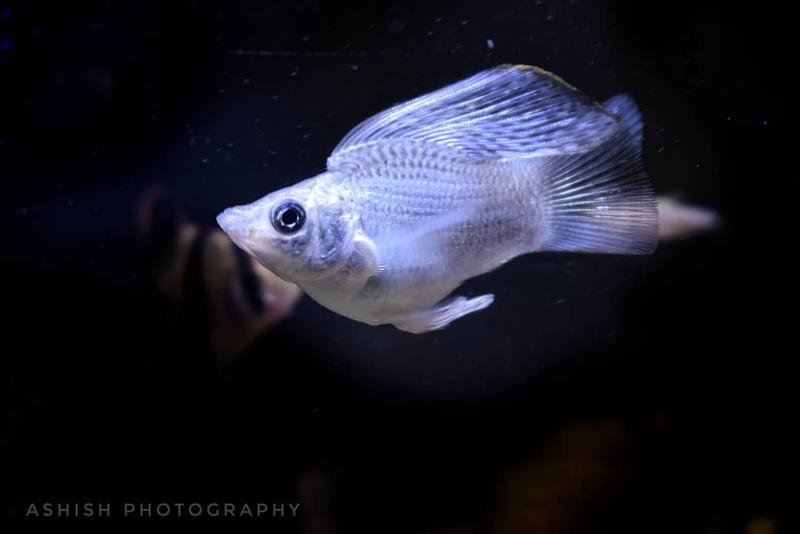
As the name suggests, these fish feature a rounded body with a “bloated” belly that resembles a balloon. That’s because of fat stored in their stomach, which makes it inflate just like a balloon.
The shape of their body is somewhat elongated. Their lower jaw is underdeveloped. Thanks to their unique appearance, balloon belly mollies are very popular aquarium fish.
While these hardy and peaceful tank mates are available in numerous varieties, they all come with a long, back fin. Most of them reach around 2 inches in length.
These small fish can be found in different color patterns. Green with reddish fins is the most common balloon molly variety. However, they are also available in orange, black, white, and blue varieties.
Key Features & Habitats
As omnivores, balloon belly mollies feed on both animal and plant matter. They usually eat crustaceans, diatoms, algae, and insect larvae in their natural habitats. In aquariums, they need a balanced diet to thrive well.
Just like other livebearers, balloon mollies carry small eggs inside of them till they’re ready to give birth to their fry. So, newly hatched fish goes into the water directly from female bellies.
In nature, balloon mollies live primarily in warm streams or tropical rivers. They prefer slightly alkaline slow-moving waters.
Mollies are typically found in brackish environments with abundant hydrogen sulfide. They enjoy sandy substrates with rocks and debris on the surface.
Their habitats usually include heavy vegetation. Acting as shelter, lush plants allow mollies to hide from predators. Vegetation is also used by young fish as a sanctuary.
- Care Level: Beginner
- Diet: Omnivores
- Temperament: Peaceful
- Maximum Size: 2 inches
- Average Lifespan: 3-5 years
- Breeding Type: Livebearers
- Water Temperature: 22-28 °C (72-82° F)
- Water pH: 7.0-8.0
- Minimum Tank Size: 20 gallons
Types of Balloon Belly Mollies
Now that you know the basic features of balloon belly molly fish, it’s time to meet different types and varieties. This will help you choose the ones that would be the best match for your tank.
There is a wide selection of molly fish varieties on the market. Marble Lyretail Molly, Platinum Lyretail Molly, Harlequin Sailfin Molly, Golden Sailfin Molly, and Gold Dust Molly, just to mention a few.
Some of the most popular balloon molly varieties include:
- Dalmatian Balloon Molly
- Black Balloon Molly Fish
- Red Balloon Mollies
- Lyretail Balloon Mollies
The primary differences between these varieties are the types of fins and color deviations.
These eye-catching fish come in different color variations. A combination of white, yellow, and black is the most common. But there are also other mixed colors in the trade.
Dalmatian Balloon Molly
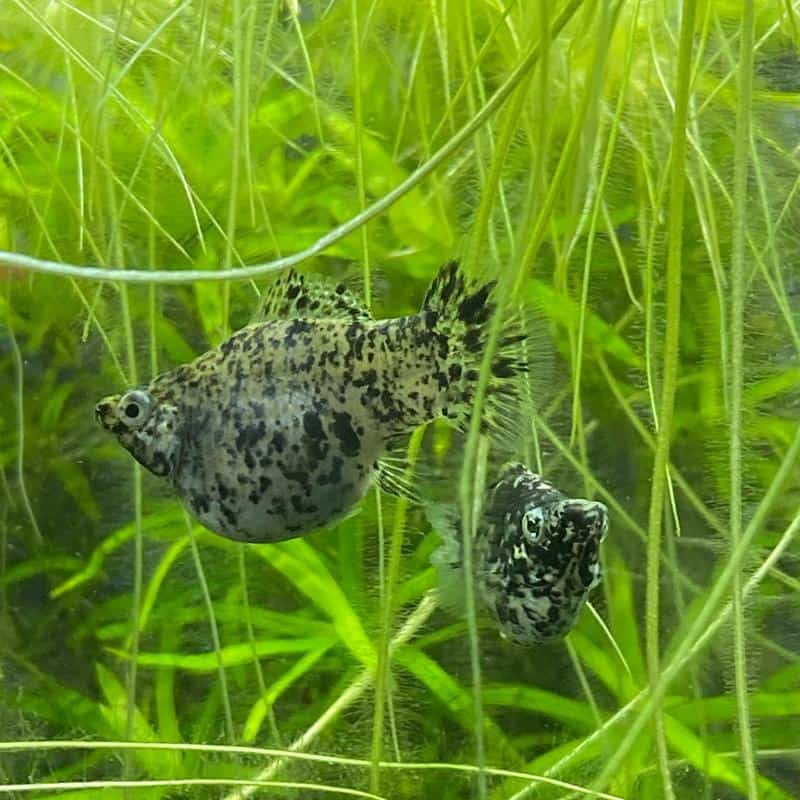
This freshwater tropical fish has color patterns that resemble a Dalmatian breed of dog. That’s why it is called Dalmatian Molly. It’s also known as Marbled Sailfin Molly and Marbled Molly.
Dalmatian balloon mollies have bulging bodies and they usually come in black-white variants. These small fish grow up to 2.5 inches in length.
Thanks to their attractive appearance, they are often kept in freshwater aquariums. They are quite hardy and can acclimate to different salt levels.
Black Balloon Molly
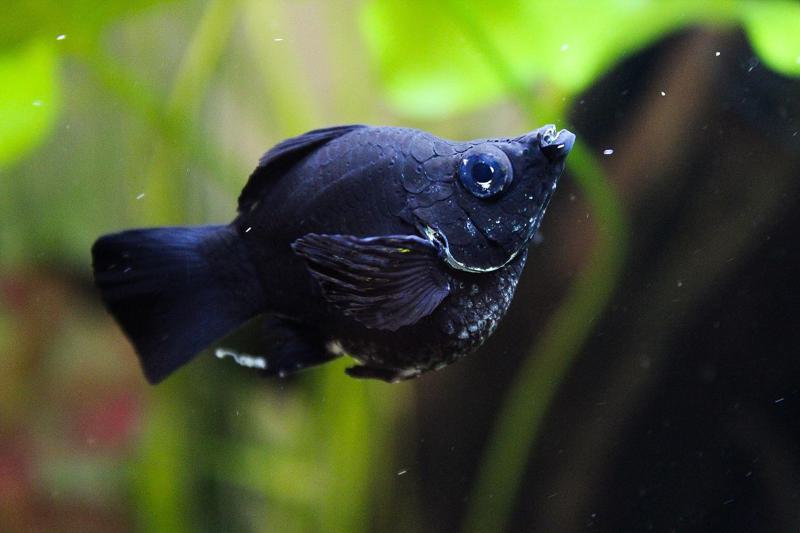
These freshwater fish originate in South America and Central America. The black balloon mollies are easy to care for, which makes them a popular choice for freshwater fish tanks.
They can withstand various water conditions. Distinct dark colors also contribute to their popularity. Black balloon molly can reach 3.5 inches in length.
As a schooling fish, black balloon mollies need to live in groups of 7 or more to thrive. They usually eat small invertebrates like crustaceans and insects.
Red Balloon Molly
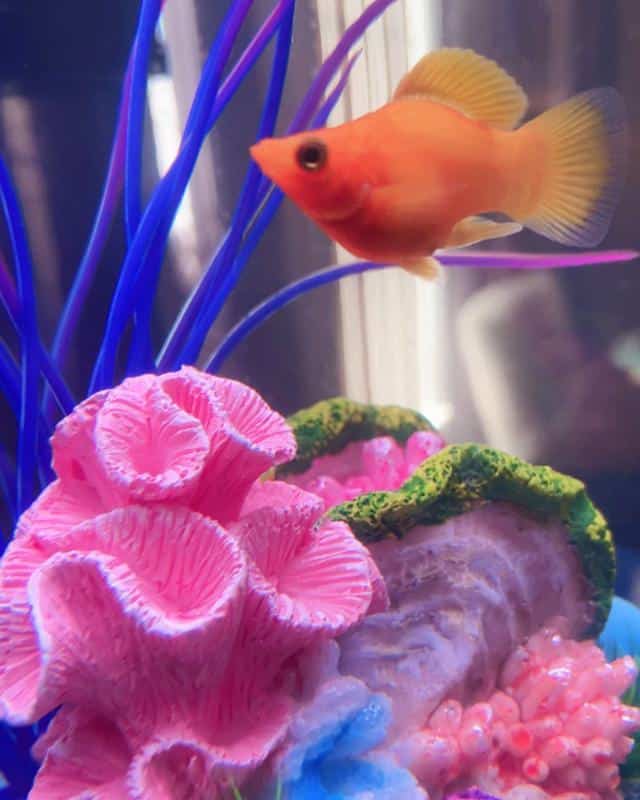
Just like other balloon mollies, this hybrid variation has a rounded abdomen and arched back. It boasts a striking dorsal fin and a large caudal fin.
As the name implies, it features a bright red color. This makes the red balloon molly an eye-catching fish that can easily attract attention in aquariums.
Red balloon mollies can adapt to different conditions in fish tanks. With gradual acclimation, they can thrive in both saltwater and freshwater aquariums.
Lyretail Balloon Molly
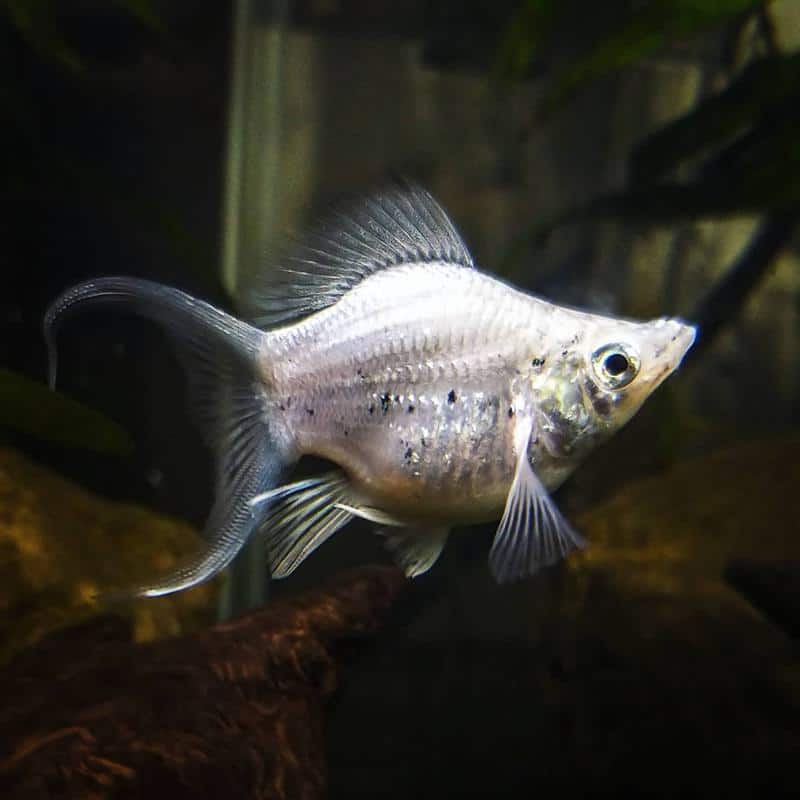
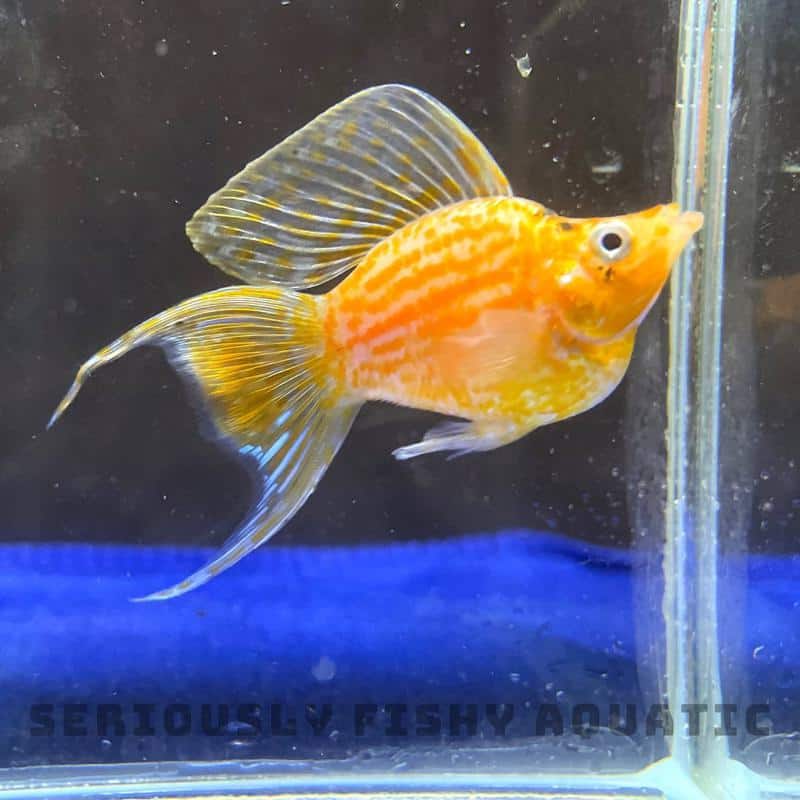
With beautiful colors and lyre-shaped tails, these tropical fish look amazing in aquariums. So, Lyretail Balloon Molly could be an ideal choice for your fish tank too.
This type of fish is capable of living in both saltwater and freshwater environments. It does not require much care. Plus, it is known for its peaceful nature.
All of these characteristics make Lyretail Balloon Mollies popular with aquarists around the world. It is great for new fishkeepers.
Body Size
Balloon belly mollies grow up to 2 inches in length. Adult full-grown individuals can reach 8 cm (about 3 inches) sometimes. As such, these are the smallest molly fish types.
Females are slightly smaller than males. Apart from that, male balloon mollies have lair tail fins as well as striking sail dorsal fins.
Females, on the other hand, have rounded fins. This differentiates them from males, so it’s not difficult to recognize them even if you’ve never kept balloon mollies before.
The back of both female and male mollies is arched with a big, spherical belly. Their caudal fins look like a lyre, making them unique in terms of shape.
Lifespan
The lifespan of balloon molly fish is measured from 3 to 5 years in general. It depends largely on genetics, diet, and care.
This is actually the life expectancy of almost all molly varieties. Remember that we don’t account for diseases, health problems, caretaking mistakes, and other negative factors.
It’s worth noting that the mortality rate of balloon molly fish is linked to their immunity, which tends to weaken after several years of inbreeding. As an owner of balloon belly mollies, you should provide them with proper caregiving to increase their lifespan.
But just because your fishy friends enjoy the perfect living conditions doesn’t necessarily mean they will enjoy a long life too. Nonetheless, you should do everything you can to make them happy. Read on to learn more!
Related: How Long Do Mollies Live?
Breeding: Reproduction and Pregnancy
Balloon molly fish tend to breed frequently and readily in aquariums with proper care. Breeding is an enjoyable hobby because it allows you to create a diverse range of colors. In this section, we will illustrate spawning in a nutshell.
As livebearers, female balloon belly mollies give birth to fry, i.e., live young. Make sure there is a spawning box with a dense algae mat and a plethora of live plants in your tank. This will encourage spawning.
Besides that, increase the water temperature to around 78°F to trigger the breeding behavior of your fish. It can do the trick.
Males will be displaying and flaring to females during mating. Once a balloon molly female is ready for reproduction, she will let the strongest males fertilize tiny eggs inside her.
After getting fertilized, eggs will remain inside for about 40 days. Thereafter, the fully-developed fry will be released. Every 60 days or so, female mollies give birth to 10-60 fries.
Be sure to separate newly born mollies from the adults to prevent them from being eaten. It is a good idea to place pregnant mollies inside the spawning box of your aquarium (add it if it lacks) before they give birth.
Balloon Molly Fish Care
Before acquiring balloon belly mollies for your fish tank, you need to know the most common problems and challenges of caring for this species. Don’t worry. The care routine is not complicated at all.
This species is suitable even for beginners since it has no special requirements. That’s not to say balloon mollies don’t have their own demands to thrive in aquariums. As a newbie fish keeper, you should try to meet them all.
This involves everything from choosing the right size of your tank setup to providing a well-balanced diet and ensuring that the water parameters are correct. We’ve got everything covered in this care section.
Tank Setup
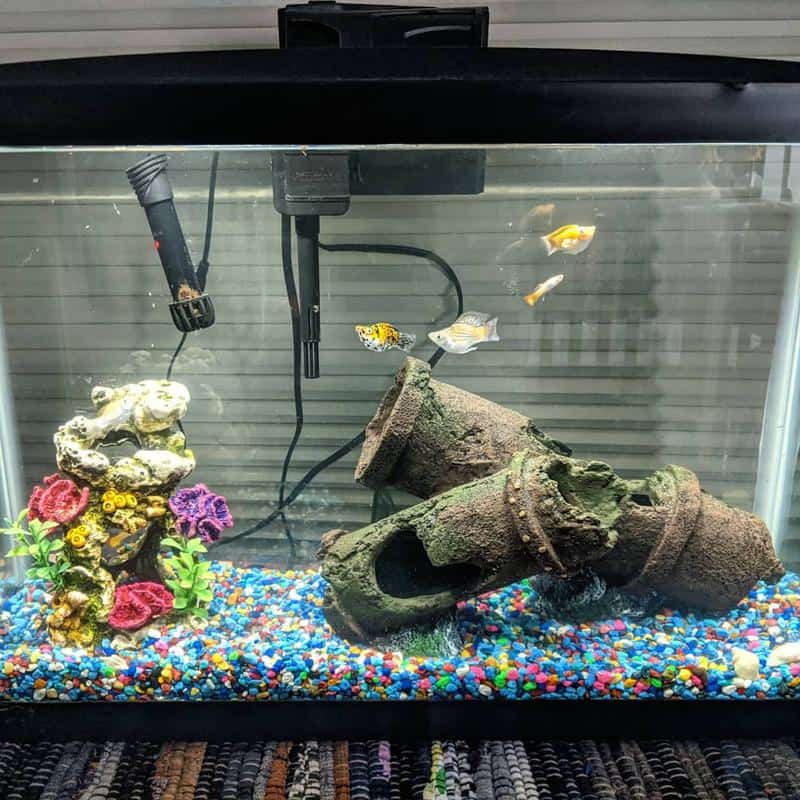
Aquarium Size
Even though balloon molly fish is a small species, sufficient space is required for a happy and tranquil life. Smaller tanks of 5 or 10 gallons would make your fish stressed and unhappy.
As a general rule of thumb, the minimum aquarium size is ought to be 20 gallons (nearly 76 liters). The larger, the better.
Ideally, your tank should be between 30 and 40 gallons for improved comfort of your fish. That will allow them to swim and breed freely.
Filtration
Filters are useful without a doubt. They can keep the water purified for longer by prolonging the intervals between water changes.
Considering that mollies live in slow-moving waters in their natural habitats, a standard biological or mechanical filtration system would be preferred.
Make sure your water filter is robust. Consider the size of your tank when deciding on its power.
By installing the proper filtration system, you will ensure that the water quality isn’t poor. It’s one of the main causes of diseases in fish.
Heaters
In addition to water filters, heaters are also helpful for fish survival. They can ensure that the water temperature in your aquarium is stable and ideal for balloon mollies.
With that said, you should consider installing an aquarium heater although it’s not absolutely necessary. It will keep the fluctuation from arising, which is bad for fish. We recommend choosing automated heaters.
Aquarium Decorations and Plants
Balloon molly fish enjoy aquarium decorations like live plants. Hornwort, Java Fern, Sagittaria, and Anubias are great choices for tank decoration.
These aquatic plants can give your mollies the feel of real natural habitat. Moreover, they will provide shelter for them while releasing oxygen and absorbing contaminants at the same time.
Combine densely populated plants with rock structures. Your balloon molly fish will like it!
Water Parameters
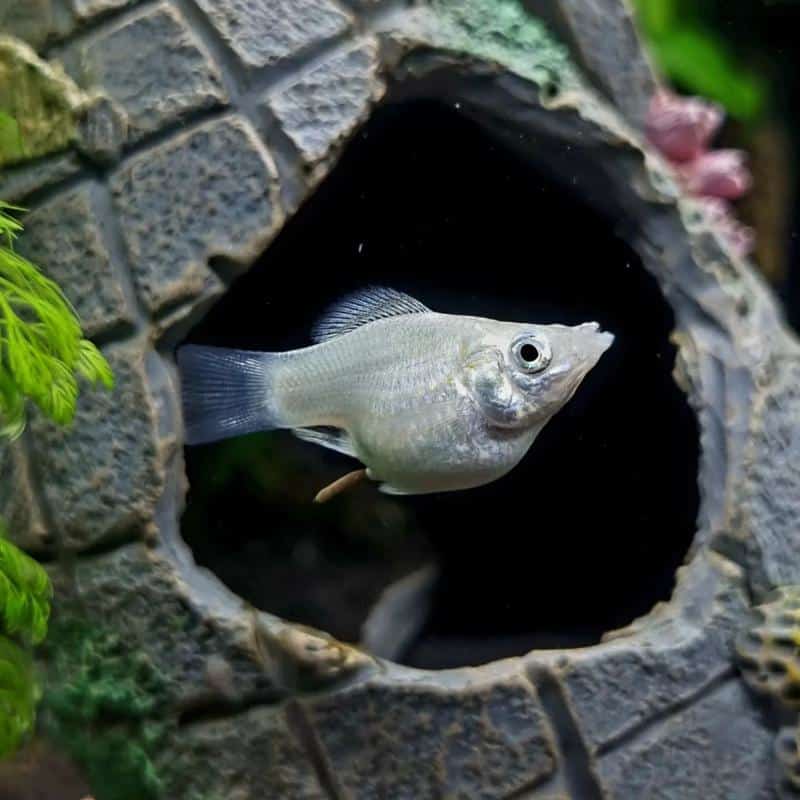
Conduct a 30% water change once a week. It will help maintain the water column and ensure that toxins don’t build up in the water.
Additionally, you need to take care of essential water parameters, such as temperature, hardness, PH levels, and salinity.
Temperature
Balloon mollies can thrive in a vast range of temperatures. However, the ideal temperature range for this hardy species falls between 72°F and 82°F.
Use water heaters and other equipment to keep water parameters stable. If you have a sizeable aquarium, it will be easier for you to keep abrupt shifts at bay.
Hardness
Remember that balloon molly fish is a species that prefers hard water. The hardness of your water should be between 15 and 30 dGH.
pH Levels
The pH level should be anywhere from 7.0 to 8.0. Check pH levels regularly (once or twice a week). Use the special pH test kit for this purpose.
Water Salinity
While balloon belly mollies can withstand small amounts of salt in water, they do not like high salinity either. So, if you want to add some salt to your tank to avoid or treat certain fish diseases, be careful not to overdo it.
The last thing you want is to harm your beloved balloon mollies. Unlike common molly fish, they can’t survive in brackish water.
Read More:
- Platy and Molly: Similarities and Differences
- Molly Fish Types: Colors, Fin & Tail Variants
- Black Molly Fish
- Molly Fish Care
Conclusion
We’ve reached the end of this guide. Hopefully, it helped you find the useful information and answers you were looking for.
You have learned how to breed and care for your balloon belly molly fish. As you can see, these omnivores are not choosy about diet and they can withstand different aquarium conditions.
Even so, you should strive to provide the best care to help them thrive in your aquarium. With proper care, balloon belly mollies can be great tank pets.